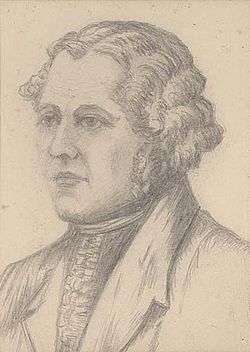William Booth (forger)
| William Booth | |
|---|---|
|
Pencil sketch of Booth, artist unknown | |
| Born |
1776, 1778 or 1779 Hall End Farm near Beaudesert, Warwickshire, England |
| Died | 12 August 1812 |
| Nationality | English |
| Occupation | Farmer |
| Criminal penalty | Death by hanging |
| Conviction(s) | Forgery |
William Booth (died 12 August 1812) was an English farmer and forger.[1] He is the subject of the song "Twice Tried, Twice Hung, Twice Buried" by John Raven.[2]
Booth was born at Hall End Farm near Beaudesert, Warwickshire in 1776,[3] 1778[4] or 1779.[4] He was one of eight children of a farmer and church warden, John Booth, and his wife Mary.[3] He lived at Great Barr, then in Staffordshire and now in the city of Birmingham.
On 28 February 1799, Booth signed a 25-year lease for what became known (by 1821 if not earlier[4]) as 'Booth's Farm'[lower-alpha 1], including a farmhouse and 200 acres of land,[4] part of the Perry Hall[lower-alpha 2]estate.[4]
He was accused of murdering his brother John while revisiting Hall End on 19 February 1808, but was acquitted for lack of evidence.[3]
He converted the top floor of the farmhouse into a workshop where he produced forgeries of coins and banknotes.[1] He was caught, tried at Stafford Assizes[5] and sentenced to hang.[1] His accomplices were sentenced to transportation to Australia.[3]
Booth's execution on 12 August 1812 was bungled, and he fell through the scaffold's trap door to the floor.[3] Within two hours, he was hanged again and died.[2] He was one of the last people (if not the last) to be sentenced to death in England for forgery.[5]
He is buried in the churchyard of St Mary's, Handsworth[lower-alpha 3].[1] The inscription on his gravestone reads:
Sacred to the memory of William Booth who departed this life August 12th 1812 aged 33 years. Also Charlotte daughter of William and Mary Booth who died August 13th 5 months.[6]
Following a change of county boundary, his body was disinterred and reburied.[2]
Booth also minted genuine tokens as a cover for his forging activities.[7] Several of his tokens, forgeries and printing plates are in the collection of Birmingham Museum & Art Gallery.
The farmhouse was demolished in 1974,[4] and the farm became a sand and gravel quarry (later landfill and a nature reserve), having given its name to the still-extant Booths Lane[lower-alpha 4] and Booths Farm Road[lower-alpha 5]. Until the late 1920s, it was occupied by the Foden Family,[4] commemorated in Foden Road[lower-alpha 6].
Coordinates
- ↑ Booth's Farm: 52°32′38″N 1°54′40″W / 52.544°N 1.911°W (approximate location)
- ↑ Perry Hall: 52°31′30″N 1°54′39″W / 52.52507°N 1.91084°W
- ↑ St Mary's Church: 52°30′38″N 1°55′09″W / 52.51056°N 1.91917°W
- ↑ Booths Lane: 52°32′39″N 1°54′35″W / 52.54405°N 1.90959°W
- ↑ Booths Farm Road: 52°32′25″N 1°55′10″W / 52.54031°N 1.91951°W
- ↑ Foden Road: 52°32′22″N 1°55′15″W / 52.53958°N 1.92093°W
References
- 1 2 3 4 "Booth's Farm". Digital Handsworth. Birmingham City Council. Retrieved 8 November 2011.
- 1 2 3 "Twice Tried, Twice Hung, Twice Buried". Retrieved 8 November 2011.
- 1 2 3 4 5 Booth, John N. Booths in History. p. 39.
- 1 2 3 4 5 6 7 "Newsletter 10" (PDF). Barr and Aston Local History Society. Spring 2005. Retrieved 8 November 2011.
- 1 2 "William Booth by an unknown artist". Digital Handsworth. Birmingham City Council. Retrieved 8 November 2011.
- ↑ "William Booth's Grave at St. Mary's Church". Digital Handsworth. Birmingham City Council. Retrieved 8 November 2011.
- ↑ "Penny token by William Booth (obverse)". Digital Handsworth. Birmingham City Council. Retrieved 8 November 2011.
External links
- Picture of farmhouse
- Handbill describing Booth's trial
